Advanced Distribution System Optimization: Utilizing Flexible Power Buses and Network Reconfiguration
Abstract
:Featured Application
Abstract
1. Introduction
State of Art
- Flexible Power Buses: The concept of flexible power buses is introduced, where each bus can dynamically adjust its active and reactive power within a predefined range in order to satisfy distribution system requirements. This flexibility allows for better adaptation to varying demand and generation conditions, enhancing overall system performance. This concept will be discussed in the next section.
- Integration of Flexible Power Buses with System Reconfiguration: The proposed algorithm systematically explores all possible radial configurations derived from the base system, incorporating flexible buses. By assessing each potential configuration, the method ensures that the global optimal solution is identified. This approach enables the distribution system to dynamically adapt to changes in demand and DG, providing a more robust and efficient operational topology.
- Optimization Framework: A comprehensive formulation of the optimization problem is presented, defining key decision variables, objective functions, and constraints. The framework integrates load flow analysis, allowing for precise adjustments to active (P) and reactive (Q) power flows. The optimization aims to minimize both operational costs and power losses, leading to a more efficient and cost-effective distribution network.
2. Overview of the Approach
2.1. Concept of Flexible Buses
2.2. Procedure
3. Methodology
3.1. Power Flow Analysis
3.1.1. Network Modeling
- Root Bus: acts as a reference point with a predefined voltage magnitude and phase angle.
- PQ Bus: defines specified levels of active (P) and reactive (Q) power.
- PV Bus: specifies active power (P) and voltage magnitude (V).
3.1.2. BIBC, BCBV, and DLF Matrices
3.2. Reconfiguration Algorithm
- Graph Representation: The network is represented as an undirected graph where is the set of buses and is the set of branches. The adjacency matrix describes the network connectivity, providing a foundation for further analysis. The MATLAB function graph is used to construct this representation [47].
- Identification of Fundamental Cycles: Fundamental cycles, which represent redundant paths that break the radial structure, are identified using MATLAB’s cyclebasis function [48]. These cycles are the primary targets for branch elimination to ensure the network maintains a radial configuration.
- Generation of Radial Configurations: All possible radial configurations are generated by selectively eliminating branches from the identified fundamental cycles. The MATLAB nchoosek function [49] is employed to calculate all possible combinations of branch elimination, ensuring that only unique configurations are considered.
- Radiality Verification: Each generated configuration is checked for radiality using the cyclebasis function again. Any configuration that still contains cycles is discarded, ensuring that only valid radial topologies are retained.
- Bus Reorganization and Branch Orientation: Before performing load flow analysis, the buses are reorganized according to their hierarchical structure. A minimum spanning tree is generated using MATLAB’s minspantree function [50], ensuring correct orientation and connectivity from the root bus towards the leaves.
3.3. Optimization Problem Formulation
- Decision Variable
- B.
- Objective Function
- represents the total active power losses of the system.
- represents the amount of flexible power used at the flexible buses.
- is the cost associated with active power losses.
- is the cost associated with the use of flexible power.
- C.
- Constraints
- Load flow equations:
- 2.
- Power at flexible buses:
- 3.
- Voltage:
- 4.
- Radiality:
- D.
- Optimizer
4. Use Cases
4.1. Kumamoto System
4.2. IEEE-33 System
5. Conclusions
Author Contributions
Funding
Institutional Review Board Statement
Informed Consent Statement
Data Availability Statement
Conflicts of Interest
References
- Shi, W.; Xie, X.; Chu, C.-C.; Gadh, R. Distributed Optimal Energy Management in Microgrids. IEEE Trans. Smart Grid 2015, 6, 1137–1146. [Google Scholar] [CrossRef]
- Chang, W.-N.; Chang, C.-M.; Yen, S.-K. Improvements in Bidirectional Power-Flow Balancing and Electric Power Quality of a Microgrid with Unbalanced Distributed Generators and Loads by Using Shunt Compensators. Energies 2018, 11, 3305. [Google Scholar] [CrossRef]
- Mahmoud, M.S.; Saif Ur Rahman, M.; A.L.-Sunni, F.M. Review of Microgrid Architectures—A System of Systems Perspective. IET Renew. Power Gener. 2015, 9, 1064–1078. [Google Scholar] [CrossRef]
- Han, Y.; Zhang, K.; Li, H.; Coelho, E.A.A.; Guerrero, J.M. MAS-Based Distributed Coordinated Control and Optimization in Microgrid and Microgrid Clusters: A Comprehensive Overview. IEEE Trans. Power Electron. 2018, 33, 6488–6508. [Google Scholar] [CrossRef]
- Wang, J.; Li, K.-J.; Javid, Z.; Sun, Y. Distributed Optimal Coordinated Operation for Distribution System with the Integration of Residential Microgrids. Appl. Sci. 2019, 9, 2136. [Google Scholar] [CrossRef]
- Hu, P.; Chen, H.; Chen, C.; Liu, X. Optimal Integration of Microgrid for Distribution Network. In Proceedings of the 2015 IEEE PES Asia-Pacific Power and Energy Engineering Conference (APPEEC), Brisbane, Australia, 15–18 November 2015; pp. 1–5. [Google Scholar]
- Liu, W.; Zhuang, P.; Liang, H.; Peng, J.; Huang, Z. Distributed Economic Dispatch in Microgrids Based on Cooperative Reinforcement Learning. IEEE Trans. Neural Netw. Learn. Syst. 2018, 29, 2192–2203. [Google Scholar] [CrossRef]
- Tong, X.; Hu, C.; Zheng, C.; Rui, T.; Wang, B.; Shen, W. Energy Market Management for Distribution Network with a Multi-Microgrid System: A Dynamic Game Approach. Appl. Sci. 2019, 9, 5436. [Google Scholar] [CrossRef]
- Babaei, S.; Jiang, R.; Zhao, C. Distributionally Robust Distribution Network Configuration Under Random Contingency. IEEE Trans. Power Syst. 2020, 35, 3332–3341. [Google Scholar] [CrossRef]
- Clavijo-Camacho, J.; Ruiz-Rodriguez, F.J. Improving the Reliability of an Electric Power System by Biomass-Fueled Gas Engine. Energies 2022, 15, 8451. [Google Scholar] [CrossRef]
- Wang, C.; Hou, Y.; Qiu, F.; Lei, S.; Liu, K. Resilience Enhancement with Sequentially Proactive Operation Strategies. IEEE Trans. Power Syst. 2017, 32, 2847–2857. [Google Scholar] [CrossRef]
- Park, S.; Shin, H. A Proactive Microgrid Management Strategy for Resilience Enhancement Based on Nested Chance Constrained Problems. Appl. Sci. 2022, 12, 12649. [Google Scholar] [CrossRef]
- Helmi, A.M.; Carli, R.; Dotoli, M.; Ramadan, H.S. Efficient and Sustainable Reconfiguration of Distribution Networks via Metaheuristic Optimization. IEEE Trans. Autom. Sci. Eng. 2022, 19, 82–98. [Google Scholar] [CrossRef]
- Lei, S.; Chen, C.; Song, Y.; Hou, Y. Radiality Constraints for Resilient Reconfiguration of Distribution Systems: Formulation and Application to Microgrid Formation. IEEE Trans. Smart Grid 2020, 11, 3944–3956. [Google Scholar] [CrossRef]
- Shariatzadeh, F.; Vellaithurai, C.B.; Biswas, S.S.; Zamora, R.; Srivastava, A.K. Real-Time Implementation of Intelligent Reconfiguration Algorithm for Microgrid. IEEE Trans. Sustain. Energy 2014, 5, 598–607. [Google Scholar] [CrossRef]
- Dall’Anese, E.; Giannakis, G.B. Risk-Constrained Microgrid Reconfiguration Using Group Sparsity. IEEE Trans. Sustain. Energy 2014, 5, 1415–1425. [Google Scholar] [CrossRef]
- Macedo, L.H.; Franco, J.F.; Mahdavi, M.; Romero, R. A Contribution to the Optimization of the Reconfiguration Problem in Radial Distribution Systems. J. Control Autom. Electr. Syst. 2018, 29, 756–768. [Google Scholar] [CrossRef]
- Kahouli, O.; Alsaif, H.; Bouteraa, Y.; Ben Ali, N.; Chaabene, M. Power System Reconfiguration in Distribution Network for Improving Reliability Using Genetic Algorithm and Particle Swarm Optimization. Appl. Sci. 2021, 11, 3092. [Google Scholar] [CrossRef]
- Yaprakdal, F.; Baysal, M.; Anvari-Moghaddam, A. Optimal Operational Scheduling of Reconfigurable Microgrids in Presence of Renewable Energy Sources. Energies 2019, 12, 1858. [Google Scholar] [CrossRef]
- Ramadan, H.S.; Helmi, A.M. Optimal Reconfiguration for Vulnerable Radial Smart Grids under Uncertain Operating Conditions. Comput. Electr. Eng. 2021, 93, 107310. [Google Scholar] [CrossRef]
- Gautam, M.; Abdelmalak, M.; MansourLakouraj, M.; Benidris, M.; Livani, H. Reconfiguration of Distribution Networks for Resilience Enhancement: A Deep Reinforcement Learning-Based Approach. In Proceedings of the 2022 IEEE Industry Applications Society Annual Meeting (IAS), Detroit, MI, USA, 9–14 October 2022; pp. 1–6. [Google Scholar]
- Shi, Q.; Li, F.; Olama, M.; Dong, J.; Xue, Y.; Starke, M.; Winstead, C.; Kuruganti, T. Network Reconfiguration and Distributed Energy Resource Scheduling for Improved Distribution System Resilience. Int. J. Electr. Power Energy Syst. 2021, 124, 106355. [Google Scholar] [CrossRef]
- Badran, O.; Mokhlis, H.; Mekhilef, S.; Dahalan, W. Multi-Objective Network Reconfiguration with Optimal DG Output Using Meta-Heuristic Search Algorithms. Arab. J. Sci. Eng. 2018, 43, 2673–2686. [Google Scholar] [CrossRef]
- Rao, R.S.; Ravindra, K.; Satish, K.; Narasimham, S.V.L. Power Loss Minimization in Distribution System Using Network Reconfiguration in the Presence of Distributed Generation. IEEE Trans. Power Syst. 2013, 28, 317–325. [Google Scholar] [CrossRef]
- Raza, A.; Zahid, M.; Chen, J.; Qaisar, S.M.; Ilahi, T.; Waqar, A.; Alzahrani, A. A Novel Integration Technique for Optimal Location & Sizing of DG Units with Reconfiguration in Radial Distribution Networks Considering Reliability. IEEE Access 2023, 11, 123610–123624. [Google Scholar] [CrossRef]
- Zimmerman, R.D.; Edmundo Murillo-Sanchez, C.; Thomas, R.J. MATPOWER: Steady-State Operations, Planning, and Analysis Tools for Power Systems Research and Education. IEEE Trans. Power Syst. 2011, 26, 12–19. [Google Scholar] [CrossRef]
- Alanazi, M.; Alanazi, A.; Abdelaziz, A.Y.; Siano, P. Power Flow Optimization by Integrating Novel Metaheuristic Algorithms and Adopting Renewables to Improve Power System Operation. Appl. Sci. 2023, 13, 527. [Google Scholar] [CrossRef]
- Wen, J.; Tan, Y.; Jiang, L.; Xu, Z. A Compound Objective Reconfiguration of Distribution Networks Using Hierarchical Encoded Particle Swarm Optimization. J. Cent. South Univ. 2018, 25, 600–615. [Google Scholar] [CrossRef]
- Hamour, H.; Kamel, S.; Abdel-mawgoud, H.; Korashy, A.; Jurado, F. Distribution Network Reconfiguration Using Grasshopper Optimization Algorithm for Power Loss Minimization. In Proceedings of the 2018 International Conference on Smart Energy Systems and Technologies (SEST), Seville, Spain, 10–12 September 2018; pp. 1–5. [Google Scholar]
- Merzoug, Y.; Abdelkrim, B.; Larbi, B. Distribution Network Reconfiguration for Loss Reduction Using PSO Method. Int. J. Electr. Comput. Eng. (IJECE) 2020, 10, 5009–5015. [Google Scholar] [CrossRef]
- Legry, M.; Dieulot, J.-Y.; Colas, F.; Saudemont, C.; Ducarme, O. Non-Linear Primary Control Mapping for Droop-Like Behavior of Microgrid Systems. IEEE Trans. Smart Grid 2020, 11, 4604–4613. [Google Scholar] [CrossRef]
- Legry, M.; Dieulot, J.-Y.; Colas, F.; Bakri, R. Model Predictive Control-Based Supervisor for Primary Support of Grid-Interactive Microgrids. Control Eng. Pract. 2023, 134, 105458. [Google Scholar] [CrossRef]
- Wang, Y.; Tang, Y.; Xu, Y.; Xu, Y. A Distributed Control Scheme of Thermostatically Controlled Loads for the Building-Microgrid Community. IEEE Trans. Sustain. Energy 2020, 11, 350–360. [Google Scholar] [CrossRef]
- Martin, A.D.; Cano, J.M.; Medina-Garcia, J.; Gomez-Galan, J.A.; Vazquez, J.R.; Martin, A.D.; Cano, J.M.; Medina-Garcia, J.; Gomez-Galan, J.A.; Vazquez, J.R. Centralized MPPT Controller System of PV Modules by a Wireless Sensor Network. IEEE Access 2020, 8, 71694–71707. [Google Scholar] [CrossRef]
- Torreglosa, J.P.; García, P.; Fernández, L.M.; Jurado, F. Energy Dispatching Based on Predictive Controller of an Off-Grid Wind Turbine/Photovoltaic/Hydrogen/Battery Hybrid System. Renew. Energy 2015, 74, 326–336. [Google Scholar] [CrossRef]
- Chen, L.; Wu, T.; Xu, X. Optimal Configuration of Different Energy Storage Batteries for Providing Auxiliary Service and Economic Revenue. Appl. Sci. 2018, 8, 2633. [Google Scholar] [CrossRef]
- Chen, Z.; Chen, Y.; He, R.; Liu, J.; Gao, M.; Zhang, L. Multi-Objective Residential Load Scheduling Approach for Demand Response in Smart Grid. Sust. Cities Soc. 2022, 76, 103530. [Google Scholar] [CrossRef]
- Li, Y.; Feng, B.; Wang, B.; Sun, S. Joint Planning of Distributed Generations and Energy Storage in Active Distribution Networks: A Bi-Level Programming Approach. Energy 2022, 245, 123226. [Google Scholar] [CrossRef]
- Chandramohan, S.; Kumudini Devi, R.P.; Venkatesh, D.B. Reliable Reconfiguration of Radial Systems—An Analysis. In Proceedings of the 2005 Annual IEEE India Conference—Indicon, Chennai, India, 11–13 December 2005; pp. 148–151. [Google Scholar]
- Li, Z.; Shahidehpour, M.; Alabdulwahab, A.; Al-Turki, Y. Valuation of Distributed Energy Resources in Active Distribution Networks. Electr. J. 2019, 32, 27–36. [Google Scholar] [CrossRef]
- Gomez-Exposito, A.; Conejo, A.J.; Canizares, C. Electric Energy Systems: Analysis and Operation; CRC Press: Boca Raton, FL, USA; London, UK; New York, NY, USA, 2020; ISBN 978-0-367-73427-5. [Google Scholar]
- Shirmohammadi, D.; Hong, H.W.; Semlyen, A.; Luo, G.X. A Compensation-Based Power Flow Method for Weakly Meshed Distribution and Transmission Networks. IEEE Trans. Power Syst. 1988, 3, 753–762. [Google Scholar] [CrossRef]
- Teng, J.-H. A Direct Approach for Distribution System Load Flow Solutions. IEEE Trans. Power Deliv. 2003, 18, 882–887. [Google Scholar] [CrossRef]
- Kumar, R.M.; Thanushkodi, K. Network Reconfiguration and Restoration in Distribution Systems through Oppostion Based Differential Evolution Algorithm and PGSA. In Proceedings of the 2013 International Conference on Current Trends in Engineering and Technology (ICCTET), Coimbatore, India, 3 July 2013; pp. 284–290. [Google Scholar]
- Certuche-Alzate, J.P.; Velez-Reyes, M. A Reconfiguration Algorithm for a DC Zonal Electric Distribution System Based on Graph Theory Methods. In Proceedings of the 2009 IEEE Electric Ship Technologies Symposium, Baltimore, MD, USA, 20–22 April 2009; pp. 235–241. [Google Scholar]
- Assadian, M.; Farsangi, M.M.; Nezamabadi-pour, H. GCPSO in Cooperation with Graph Theory to Distribution Network Reconfiguration for Energy Saving. Energy Convers. Manag. 2010, 51, 418–427. [Google Scholar] [CrossRef]
- Graph—Graph with Undirected Edges—MATLAB—MathWorks España. Available online: https://es.mathworks.com/help/matlab/ref/graph.html (accessed on 25 October 2024).
- Cyclebasis—Fundamental Cycle Basis of Graph—MATLAB—MathWorks España. Available online: https://es.mathworks.com/help/matlab/ref/graph.cyclebasis.html (accessed on 25 October 2024).
- Nchoosek—Coeficiente Binominal o Todas Las Combinaciones—MATLAB—MathWorks España. Available online: https://es.mathworks.com/help/matlab/ref/nchoosek.html (accessed on 25 October 2024).
- Minspantree—Minimum Spanning Tree of Graph—MATLAB—MathWorks España. Available online: https://es.mathworks.com/help/matlab/ref/graph.minspantree.html (accessed on 25 October 2024).
- Fmincon—Encontrar El Mínimo de Una Función Multivariable No Lineal Restringida—MATLAB—MathWorks España. Available online: https://es.mathworks.com/help/optim/ug/fmincon.html (accessed on 25 October 2024).
- Absil, P.-A.; Tits, A.L. Newton-KKT Interior-Point Methods for Indefinite Quadratic Programming. Comput. Optim. Appl. 2007, 36, 5–41. [Google Scholar] [CrossRef]
- Roy, N.K.; Pota, H.R.; Anwar, A. A New Approach for Wind and Solar Type DG Placement in Power Distribution Networks to Enhance Systems Stability. In Proceedings of the 2012 IEEE International Power Engineering and Optimization Conference, Melaka, Malaysia, 6–7 June 2012; IEEE: Piscataway, NJ, USA; pp. 296–301. [Google Scholar]
- Ruiz-Rodriguez, F.J.; Kamel, S.; Hassan, M.H.; Duenas, J.A. Optimal Reconfiguration of Distribution Systems Considering Reliability: Introducing Long-Term Memory Component AEO Algorithm. Expert Syst. Appl. 2024, 249, 123467. [Google Scholar] [CrossRef]
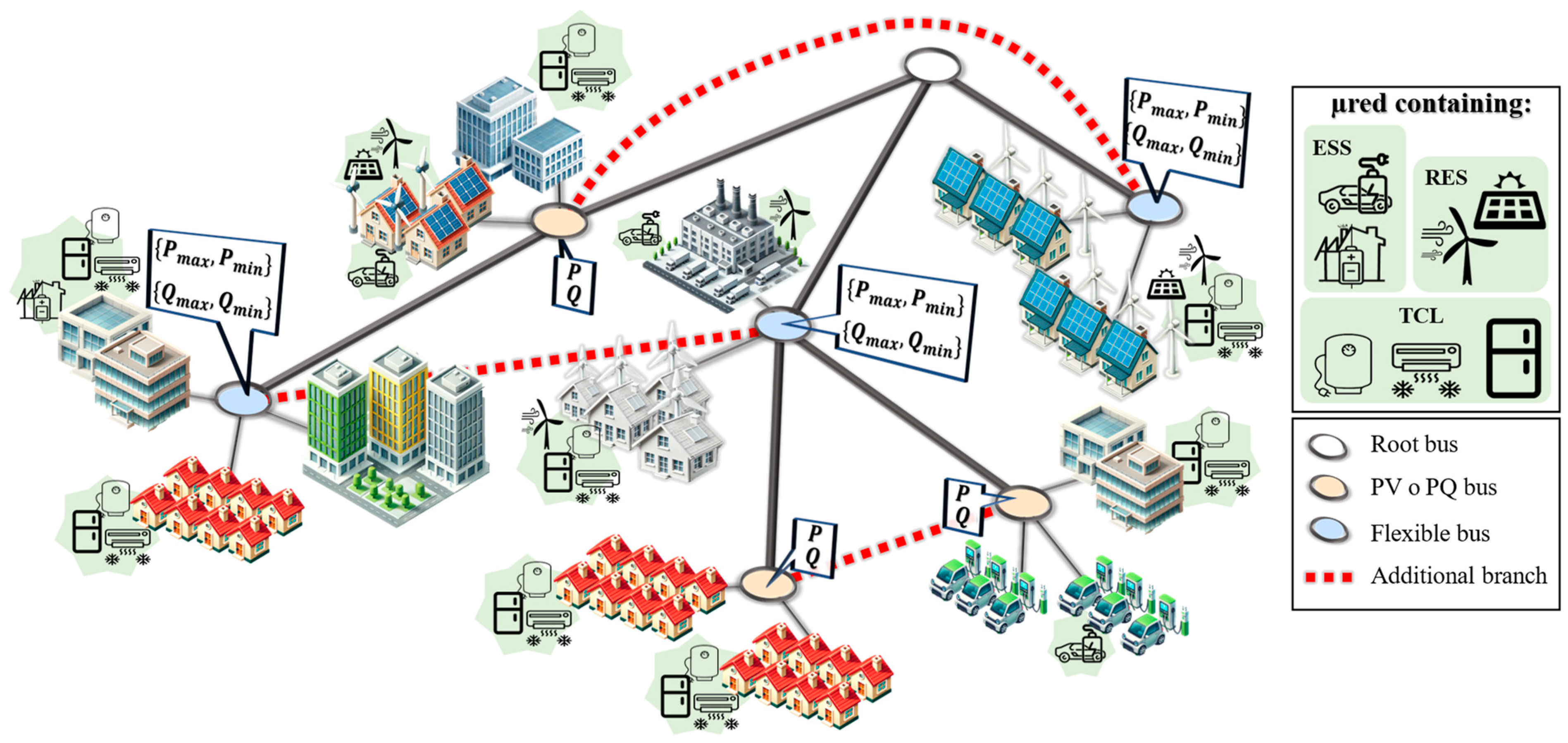
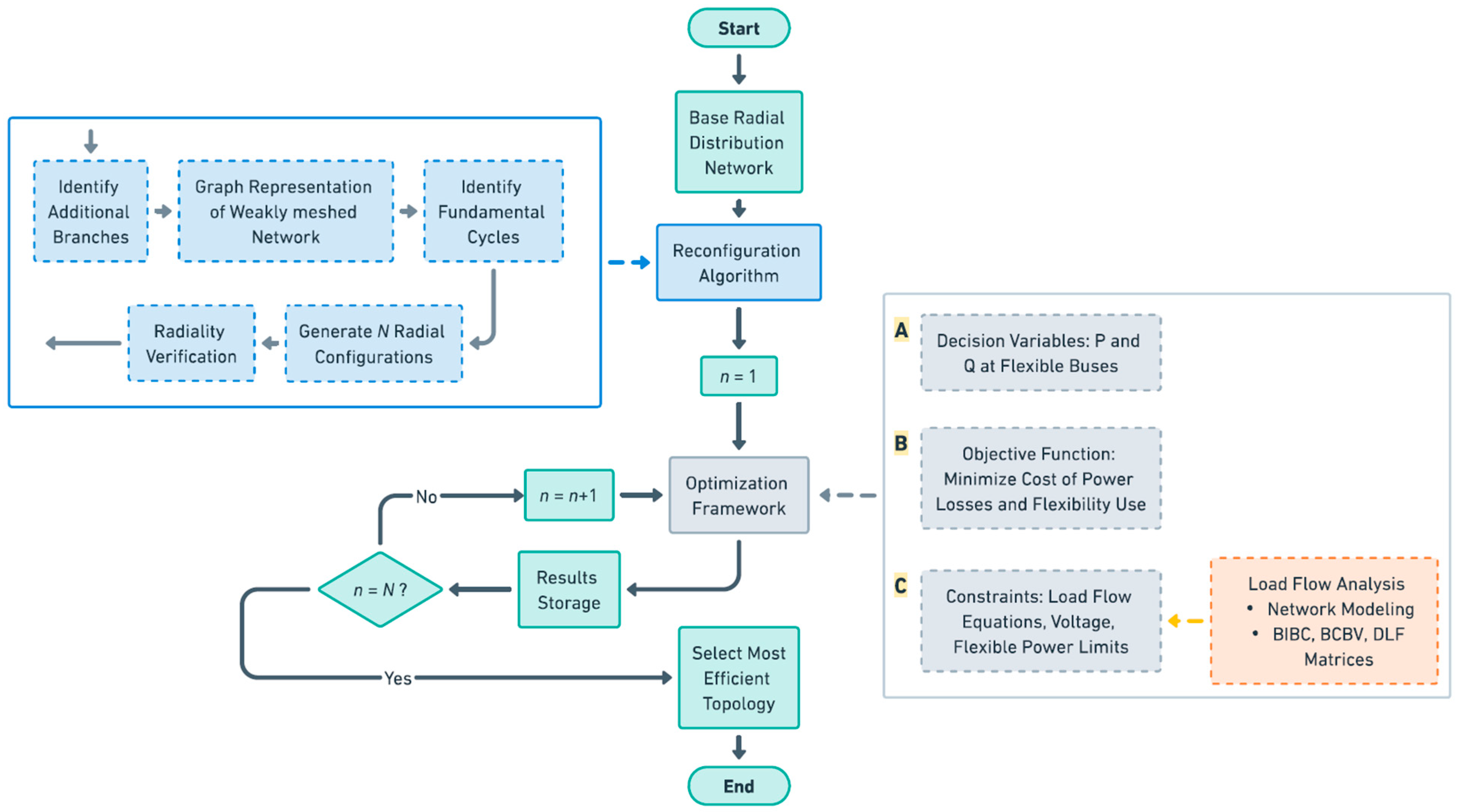


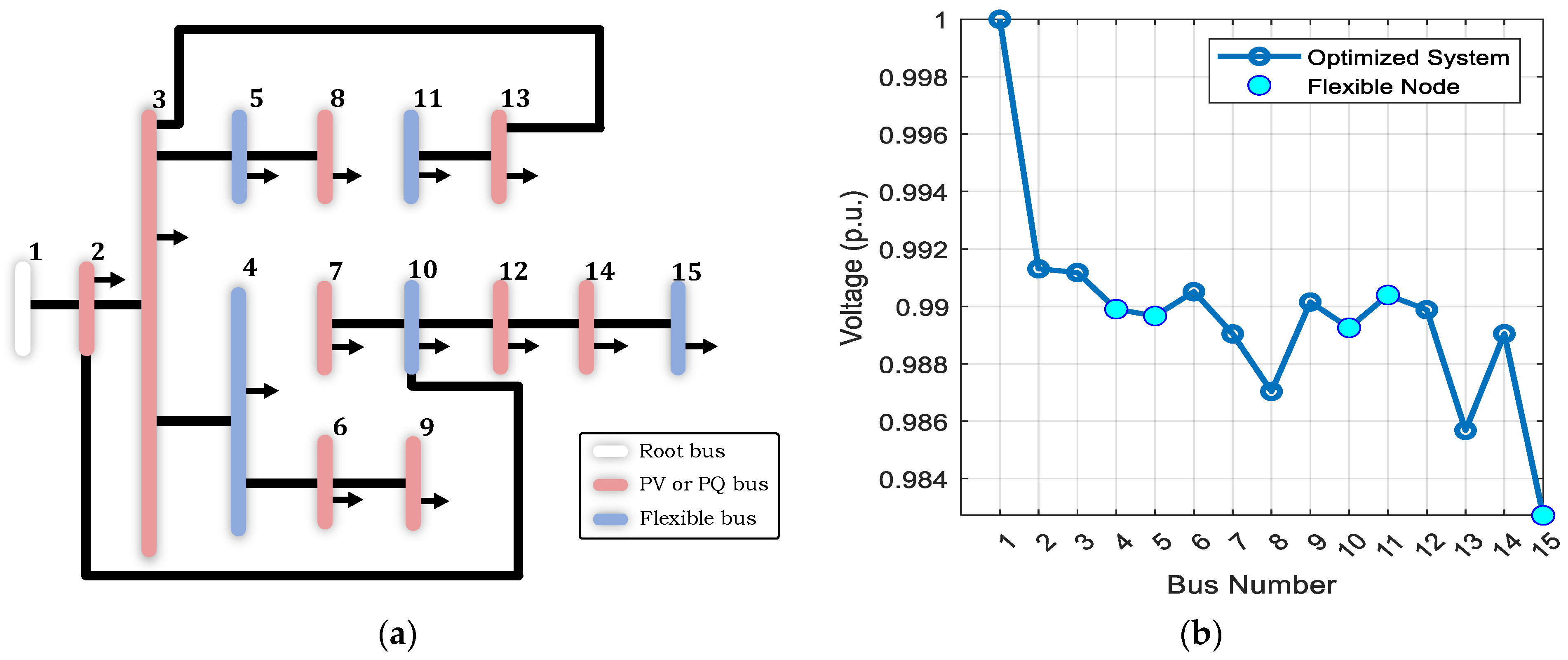


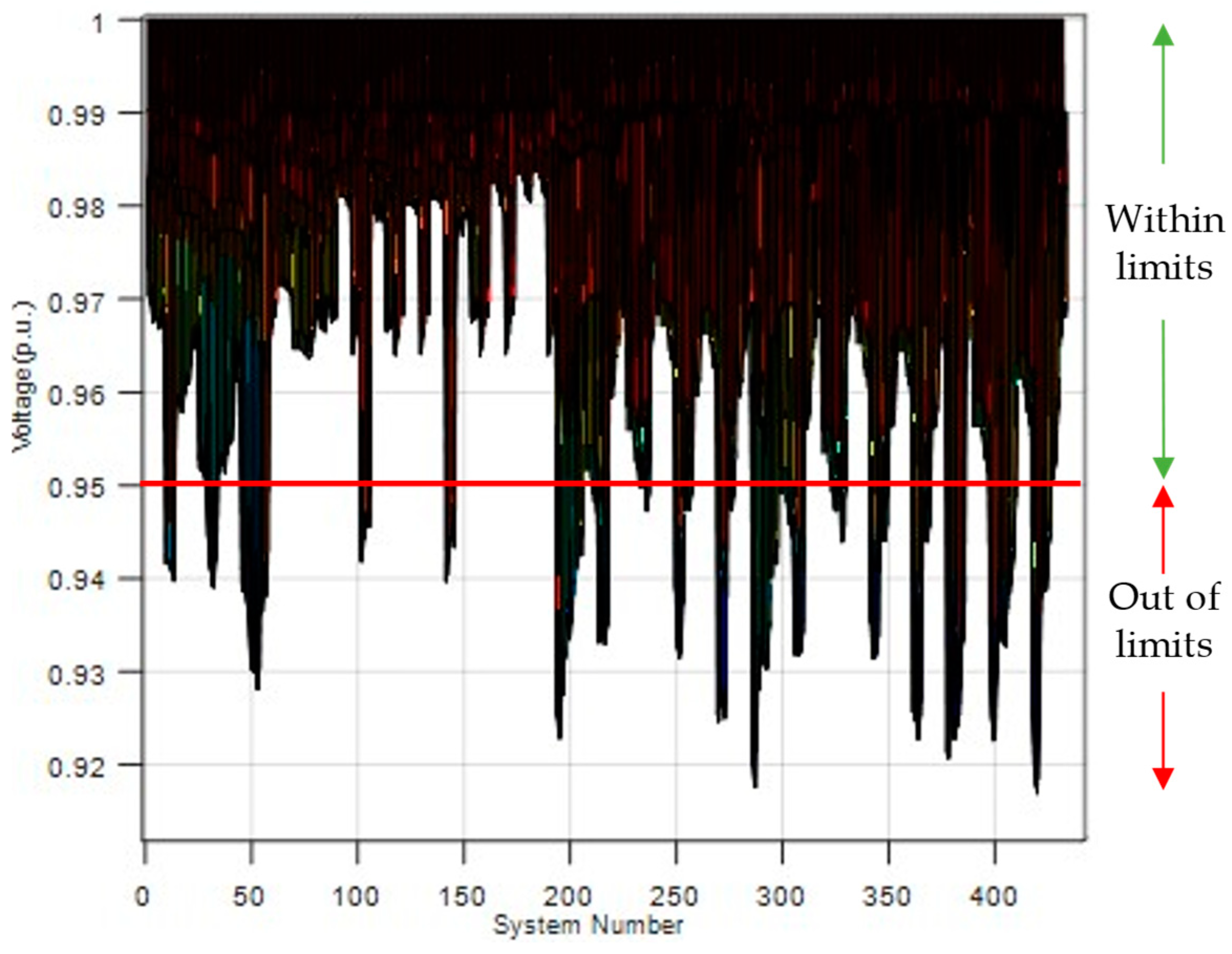
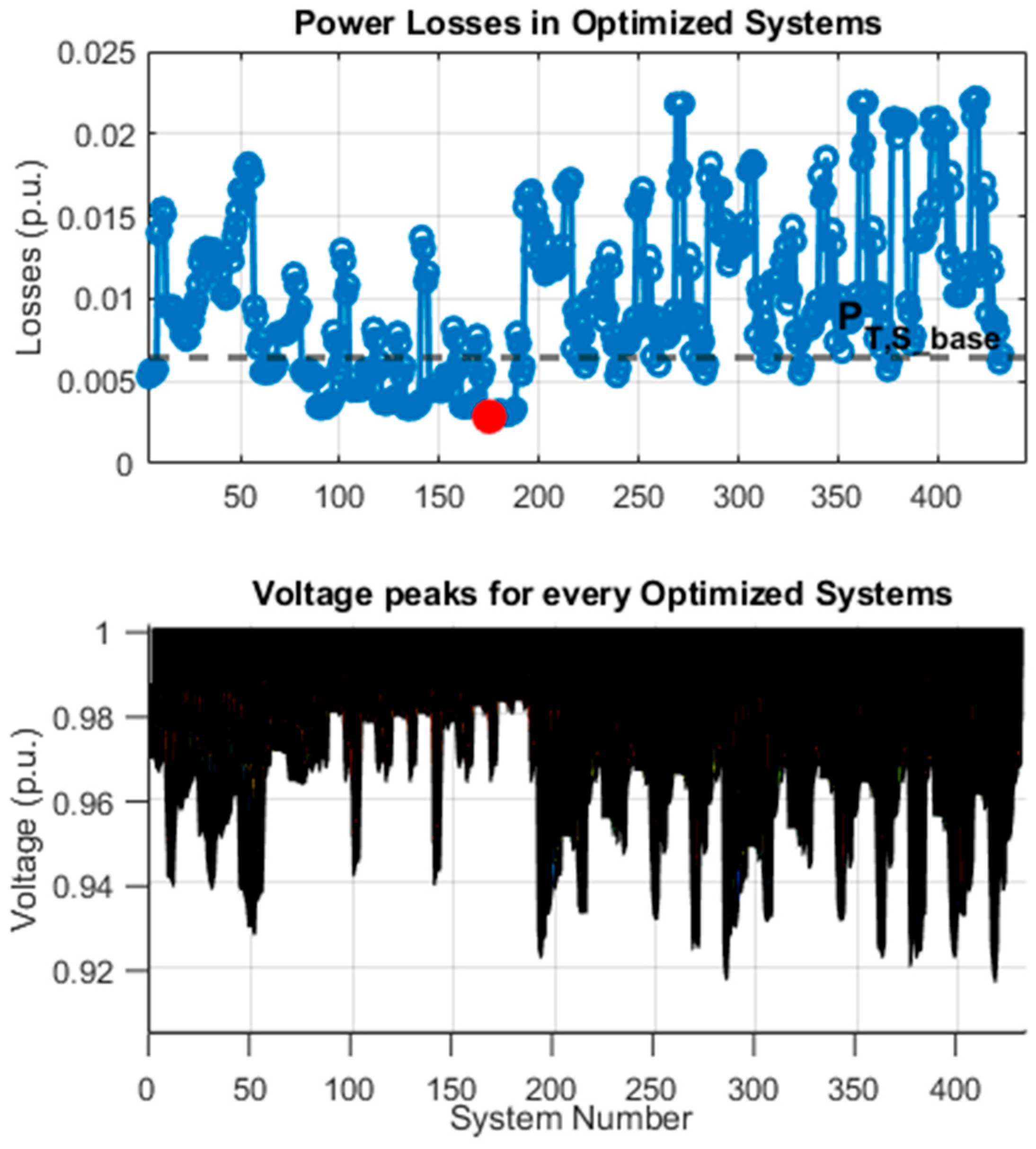
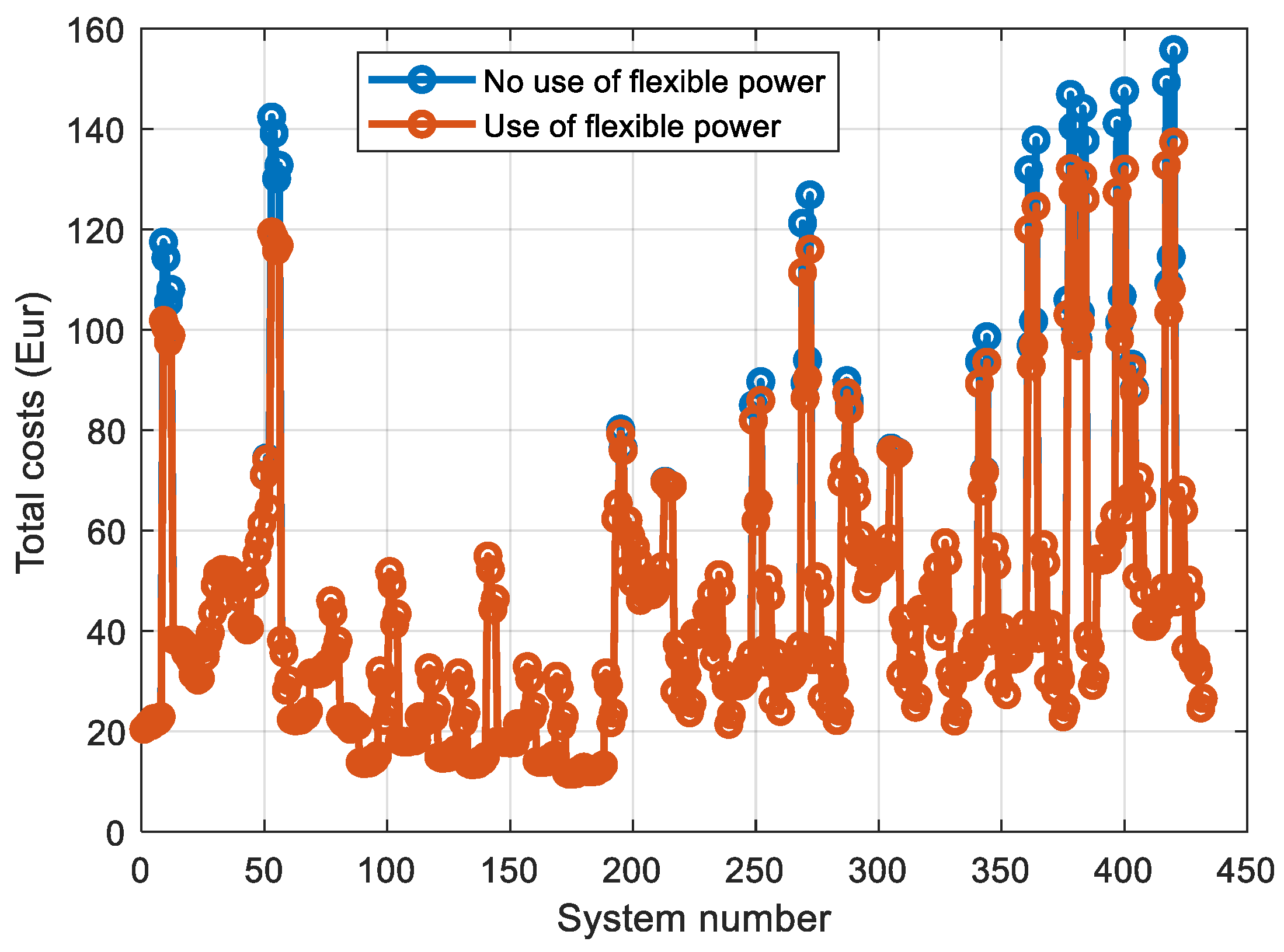

| From | To | R (p.u.) | X (p.u.) |
|---|---|---|---|
| 6 | 14 | 0.0607 | 0.00754 |
| 15 | 8 | 0.00732 | 0.01694 |
| 3 | 13 | 0.0307 | 0.032346 |
| 2 | 10 | 0.0012 | 0.022 |
| Bus Number | Interval over Initial Value (%) | (p.u.) | (p.u.) | ||||
|---|---|---|---|---|---|---|---|
| Minimum Value | Initial Value (Base) | Maximum Value | Minimum Value | Initial Value (Base) | Maximum Value | ||
| 4 | 50 | 0.0479 | 0.0958 | 0.1437 | 0.0049 | 0.0098 | 0.0147 |
| 5 | 50 | 0.0066 | 0.0132 | 0.0198 | 0.0007 | 0.0014 | 0.0021 |
| 10 | 50 | 0.01615 | 0.0323 | 0.04845 | 0.00165 | 0.0033 | 0.00495 |
| 11 | 50 | 0.00805 | 0.0161 | 0.02415 | 0.0008 | 0.0016 | 0.0024 |
| 15 | 50 | 0.1085 | 0.2170 | 0.3255 | 0.011 | 0.0220 | 0.033 |
| Bus Number | Interval over Initial Value (%) | (p.u.) | (p.u.) | ||||
|---|---|---|---|---|---|---|---|
| Minimum Value | Initial Value (Base) | Maximum Value | Minimum Value | Initial Value (Base) | Maximum Value | ||
| 9 | 35 | 0.00039 | 0.0006 | 0.00081 | 0.00013 | 0.0002 | 0.00027 |
| 5 | 50 | 0.0003 | 0.0006 | 0.0009 | 0.00015 | 0.0003 | 0.00045 |
| 17 | 15 | 0.00051 | 0.0006 | 0.00069 | 0.00017 | 0.0002 | 0.00023 |
| 21 | 20 | 0.00072 | 0.0009 | 0.00108 | 0.00032 | 0.0004 | 0.00048 |
| 25 | 32 | 0.00286 | 0.0042 | 0.00554 | 0.00136 | 0.002 | 0.00264 |
Disclaimer/Publisher’s Note: The statements, opinions and data contained in all publications are solely those of the individual author(s) and contributor(s) and not of MDPI and/or the editor(s). MDPI and/or the editor(s) disclaim responsibility for any injury to people or property resulting from any ideas, methods, instructions or products referred to in the content. |
© 2024 by the authors. Licensee MDPI, Basel, Switzerland. This article is an open access article distributed under the terms and conditions of the Creative Commons Attribution (CC BY) license (https://creativecommons.org/licenses/by/4.0/).
Share and Cite
Clavijo-Camacho, J.; Ruiz-Rodríguez, F.J.; Sánchez-Herrera, R.; Alamo, A.C. Advanced Distribution System Optimization: Utilizing Flexible Power Buses and Network Reconfiguration. Appl. Sci. 2024, 14, 10635. https://doi.org/10.3390/app142210635
Clavijo-Camacho J, Ruiz-Rodríguez FJ, Sánchez-Herrera R, Alamo AC. Advanced Distribution System Optimization: Utilizing Flexible Power Buses and Network Reconfiguration. Applied Sciences. 2024; 14(22):10635. https://doi.org/10.3390/app142210635
Chicago/Turabian StyleClavijo-Camacho, Jesus, Francisco J. Ruiz-Rodríguez, Reyes Sánchez-Herrera, and Alvaro C. Alamo. 2024. "Advanced Distribution System Optimization: Utilizing Flexible Power Buses and Network Reconfiguration" Applied Sciences 14, no. 22: 10635. https://doi.org/10.3390/app142210635
APA StyleClavijo-Camacho, J., Ruiz-Rodríguez, F. J., Sánchez-Herrera, R., & Alamo, A. C. (2024). Advanced Distribution System Optimization: Utilizing Flexible Power Buses and Network Reconfiguration. Applied Sciences, 14(22), 10635. https://doi.org/10.3390/app142210635








